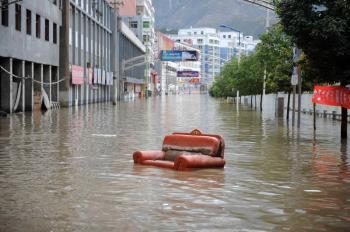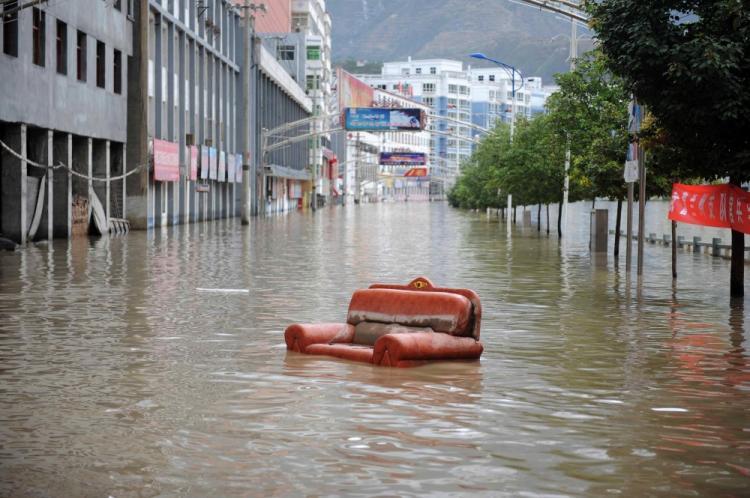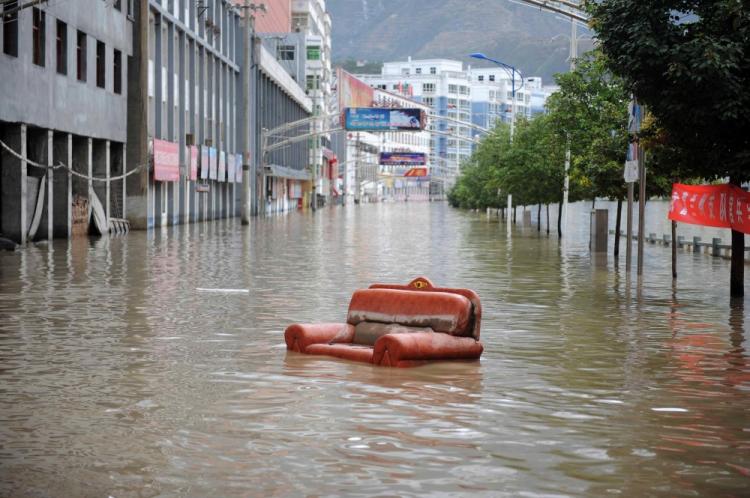[ Officials Force People to Donate to Flood Relief in China ]
This year’s summer rains have been a season of devastation and suffering in China as rivers have often registered record-breaking flood levels. Among multiple disasters, the recent mudslides in northwestern China’s Gansu Province stand out.
Thousands died there who would be alive today if the recommendations of experts had been followed. The failure to protect the population in Gansu Province calls attention to the way in which state policies have combined with this year’s heavy rains to produce an especially destructive flood season in China.
On Aug. 7, mudslides engulfed several villages in Zhouqu County in Gansu Province. As of Aug. 16, official media reported 1,254 deaths with 490 missing. Local residents said the death toll was much higher.
An investigation by the Ministry of Land and Resources in December 2008 had named Zhouqu County as the place in China most in danger from landslides. According to an article in the magazine Twenty-First Century Business Commentary, because of the county’s special geological environment, geologists recommended relocating the residents of 22 villages.
Such a massive relocation would not have been cheap and was more than the county could afford. A report to the Provincial People’s Congress in January 2009 estimated the project would cost 340 million yuan (approximately US$50 million). In 2008, the county’s total revenue was 23.8 million yuan (US$3.5 million).
Clearly, having Zhouqu County fund this was not possible. The officials of Gansu Province would have needed to act promptly to remove the 130,000 residents of Zhouqu County from the dangers predicted by the Ministry of Land and Resources.
But nothing was done. The situation in Zhouqu County is unique only in the staggering loss of life suffered on a single day. A lack of will or foresight needed to protect the population in the planning of China’s water development has been a general problem, according to one expert.
Dr. Wang Weiluo is an engineer who participated in the Three Gorges project-feasibility study in the 1980s and has since closely followed how the Chinese state uses its water resources. He holds a doctorate degree in land-use planning and currently works for an engineering firm in Germany.
According to Dr. Wang, the leaders of Chinese regional governments hope to use development, in particular the development of water resources, to display political achievements. They often pay attention only to immediate personal benefits they gain from construction projects and ignore the long-term interests of the citizenry.
Overdevelopment
Dr. Wang said that, apart from the rainfall, the main reasons for the Zhouqu County disaster were the overdevelopment of the Bailong River valley and the city planning and construction in Zhouqu County.
The town of Zhouqu County is located in a long, narrow valley along the Bailong River, in a mountainous area with the residential areas concentrated on the river’s narrow banks. However, the town was developed as though it were a city on flatland along a river.
The Bailong River has had its channel artificially straightened, narrowed, and deepened. The channelization of the river makes it more suitable for generating hydroelectric power.
A series of cascades—a series of hydroelectric dams—was built on the river, with over 15 hydroelectric projects built in Zhouqu County. The dams have been constructed to have a high-water level, which makes more likely that the banks on both sides may have landslides.
Complicating the situation in Zhouqu County is its deforestation. Professor Zheng Fengtian of People’s University in China was quoted in the Morning Newspaper (Xinwen Chenbao) as saying that from the 1950s to the 1990s, about 1.9 million mu (approximately 313,000 acres) of forest were cut in Zhouqu County.
Professor Zheng said that as the mountainous area lost its vegetation, the area’s ability to regulate floods was reduced, and the soil was more easily eroded.
The earth and stone excavated for the construction of the hydroelectric dams also increased the potential for landslides. The material has backfilled the valley, becoming abundant loose material available for landslides.
There was a major landslide in Zhouqu County in 1992, and there have been several landslides in recent years. In 1996, local officials began to build structures to block debris from sliding down but did not finish the project.
Severe Flooding
The Office of State Flood Control and Drought Relief Headquarters published statistics on July 30 that said that this year in China a total of 28 provincial cities have experienced floods, destroying 9,172 thousand hectares (approximately 23,000 acres) of crops and affecting 137 million people, killing 991, leaving 558 missing, collapsing 1.07 million houses, and threatening 10 million people, with direct financial losses of 193.5 billion yuan (approximately US$28.5 billion).
Deputy head of the Ministry of Water Resources Liu Ning said on July 21 that since the start of summer, violent and sudden storms have severely flooded over 100 cities of medium or larger size. In the entire country, over 230 rivers have experienced emergency flood levels, and 25 middle-size and small rivers have had record-breaking floods. Over 2 million people took part in rescue efforts.
Dr. Wang said that after the big floods of 1998, the Chinese government promoted a policy of “returning farmland to forestry” and “returning farmland to lakes”—replanting trees in all farmland with a gradient of over 25 percent and turning all the farmland that was originally lake back into lakes.
A few years ago, this policy was stopped because the state needs to maintain 296.5 million acres of farmland in order to secure a stable grain supply for China. The urbanization of China has steadily absorbed former agricultural land for construction. In order for the Chinese state to guarantee the baseline, it has reverted to policies that sacrifice the environment.
Dr. Wang believes the overdevelopment of China’s rivers, including the building of large numbers of water reservoirs, has led to China’s river landscape losing the ability to regulate itself. And that is the biggest reason for the seriousness of the floods this summer. Currently in China, there are 86,000 reservoir construction projects, the highest number in the world.
In China, regional governments can apply for funding to build reservoirs in the name of producing electricity and prevent flooding. A high-ranking expert who wished to remain anonymous told The Epoch Times that the hydrological bureaus in the regional governments actually welcome floods because “this way the central government will invest more funds to engineering projects.”
“It’s like bad doctors who wish more people will become ill so they can make more money,” the expert said.
This article first appeared in the New Epoch Weekly.






